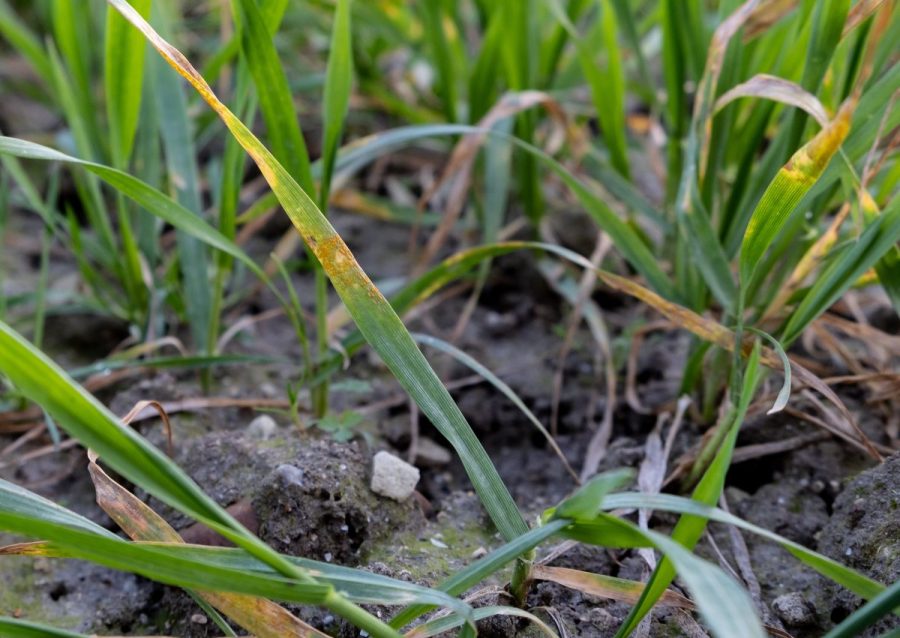The past three seasons alone have demonstrated that when it comes to disease, it’s impossible to predict what may strike the hardest. For this month’s Common Ground, CPM explores the importance of keeping an open mind when planning profitable winter wheat fungicide programmes.
“There’s an increasing demand for versatility and all-round strength.” ANDREW SMOOKER
By Janine Adamson
While the disease of the past season has undoubtedly been yellow rust, with associated concerns regarding the Yr15 gene, experts remain confident in the performance of current fungicides.
However, with no two seasons ever the same, growers are being urged to take a fresh perspective on the upcoming winter wheat crop, concentrating on what can be done, rather than what can’t, when planning crop protection programmes.
To discuss this further, CPM hosts senior scientist from Niab, Dr Aoife O’Driscoll; BASF’s agronomy manager, Andrew Smooker; and cereal fungicide business development manager for BASF UK, Jared Bonner.
The 2025 season
To open up the discussion, Aoife explained that the past season offered extremes. “We had an exceptionally warm and dry spring with stress in the crop that capped yield potential early on.
“In terms of disease expression, this was uneven across not only the country, but across farms and within crops. Septoria, which is usually dominant, was held back by the lack of leaf wetness in April and May, but then we had the issue with yellow rust which made the headlines. Individuals had to adapt quickly if they were affected.”
Andrew agreed, adding that it was another rollercoaster season. “Ultimately, it’s been a year of relentless challenges on farm right through to harvest, although there were pockets that fared a little better where rainfall and soil type allowed.
“It may also be viewed as a lower disease pressure season overall, but actually, the rust we saw in our trial sites was very high by the time it came to review the trials, with some untreated plots completely succumbing. As ever, lots of twists and turns.”
Yellow rust
While the Yr15 gene being overcome by yellow rust has made farming headlines, Aoife pointed out that although it’s very interesting biologically, agronomically, it’s yet to make such an impact.
“I don’t think it affected many situations this past year because if you’re used to dealing with yellow rust, you’re accustomed to it. It was the minority who aren’t used to dealing with it who were caught out.
“It’s likely this is because it was a new issue to them and they were following advice to apply a T0 of 0.5 l/ha of tebuconazole, which only provides a week of protection. The preferred approach would have been to go for a tebuconazole and strobilurin mix, adding perhaps £10/ha to the spray programme, but doubling the protection in terms of curative activity and persistence.”
She added that with the recently adjusted yellow rust ratings on the Recommended List, variety choice will require further consideration, although understanding how to manage the disease effectively should be the primary factor. “I don’t think people will make the same mistake twice if they’ve had an issue this year.”
Reflecting further on varieties, Jared pointed out that 15 varieties make up around 98% of the total UK winter wheat area, and at the beginning of last season, only three of those had a yellow rust rating of 6 or less.
“But by the end of the season, that increased to 11 out of the 15, which is about 70% of the area. Of course, seed crops were planted last year so there can’t be a dramatic change in availability. Instead, it’s understanding which varieties are now susceptible to yellow rust and how to manage them in the correct way.
“Think ahead – don’t necessarily shy away from varieties which are proven to be good on farm – and plan fungicide programmes accordingly,” he advised.
Andrew reminded of the interaction between varieties and chemistry: “It’s important they work together and support each other.
“This is a season where there’s been a significant change on the varietal front with yellow rust, but if you can get the programme right, you can still have a good outcome.
“There are also varieties with different genetic backgrounds on yellow rust as well, plus many other diseases and traits to think about and weigh up as ever.”
Achieving control
Discussing current fungicide options, Jared said despite the new strain of yellow rust, it remains a fairly easy disease to control with the tools available. “It does, however, require a different mindset because it cycles a lot quicker. If you take septoria, most of the fungicide programme is built around that disease with four weeks between sprays, because it’s cycling every 21-28 days.
“But yellow rust, in the right temperatures, can cycle in 10 days or less. So if you’ve planted a yellow rust susceptible variety you can’t rely on a classic T0 and returning again at T1, it requires monitoring in between.
“This is where you tend to see a T0.5 or T1.5 timing for example, where people are potentially coming back in as a top-up for yellow rust control.”
He stressed nothing has fundamentally changed with the chemistry itself. “It’s more about active management – if you’re looking at a T1 and see you have active yellow rust, ask whether an eradicant is required as well as the protectant in the tank.”
In response, Andrew pointed out that while there have been no changes in the chemistry intrinsically, during the past three years with high septoria, brown rust and yellow rust, there’s more to contend with.
“There’s an increasing demand for versatility and all-round strength; chemistry has been really tested in recent years, both in terms of disease control and value for money.
“Although there’s a general focus on every timing, T2 can take the limelight. But with the unpredictability of the past few seasons and risk management, more emphasis has to shift towards T0 and T1.”
The role of azoles
According to Aoife, Revysol (mefentrifluconazole) remains the top azole in the market for septoria control. “We have to consider what we have available to us in terms of SDHIs, strobilurins and QiI’s in fenpicoxamid, but as an azole for septoria control, Revysol is definitely the best that we have.
“We require azoles as the backbone of all fungicide programmes at T1 and T2, and because tebuconazole and prothioconazole have only modest activity, Revysol has to be in there in some form. Both biologically and agronomically, it’s very important to have it in the programme.”
Jared added that Revystar XE (mefentrifluconazole+ fluxapyroxad) proved good value last year and remains a strong offer when it comes to septoria control, while offering other robust activity on yellow and brown rust.
“Often the Xemium (fluxapyroxad) component of Revystar XE is forgotten, but this brings additional rust, eyespot and mildew activity. This means Xemium is a good partner for Revysol; in increasingly unsettled years, we have to be ticking more boxes than just septoria, we want that all-rounder.
“Equally, when it comes to resistance management, we have to bring other actives into play. With perhaps an over-reliance on prothioconazole as a partner, using Revysol as a different azole in a fungicide programme is an important factor.”
Andrew raised the heritage associated with the azole family. “They’ve stood the test of time and on-farm, I believe there’s an affection towards some of the actives that have come and gone like epoxiconazole, and obviously prothioconazole that we still have.”
In reply, Aoife said it’s well understood that SDHIs are more susceptible to faster shifts in resistance, but azoles are more balanced in terms of how mutations develop. “Some mutations leave, some come back in again, so even though there’s been a shift, overall, azoles have been very stable.
“SDHIs tend to be a little unpredictable; so how do you manage that instability? You add something in there that’s stable, therefore Revysol is offering quite a lot to the other molecules.”
Choosing flexibility
With growers facing increasingly difficult decisions regarding the bottom line, while still managing a multitude of risk factors beyond their control, Jared proposed the value of flexibility.
“If you can use products where there’s some flexibility in application rate, you have the potential to tailor their use to the situation that’s in front of you.
“This means not being tied to a set rate that could potentially be too high for a specific situation. Equally, simple considerations such as can it be used at different timings or in a different crop? It’s avoiding having products sat in the shed that have to wait for the next season.”
Andrew pointed out that also linked to value are the added benefits which can be achieved from using fungicides. “That could mean better water use efficiency, increases in nitrogen use efficiency (NUE) or maintaining green leaf area – there’s robust data to back these claims up for Revystar XE.
“These are aspects which when margins are tight and yield is challenging, can help to push a crop on. If something is paying for itself beyond chemistry terms, then that’s a positive well beyond just disease control.”
Any other business
Aoife suggested that for now, the best approach is to focus on drilling a crop into good conditions. “Psychologically, it’s not wise to get drawn into worrying about things beyond your control.”
Jared agreed: “For now, concentrate on getting good, healthy crops established and tackling any grassweed problems. The only caveat being, you may want to be more vigilant on certain varieties which have had their RL yellow rust scores adjusted.
“Let’s hopefully get crops off to a good start and see what next year has in store,” he concluded.
This article was taken from the latest issue of CPM. Read the article in full here.
For more articles like this, subscribe here.
Sign up for Crop Production Magazine’s FREE e-newsletter here.




